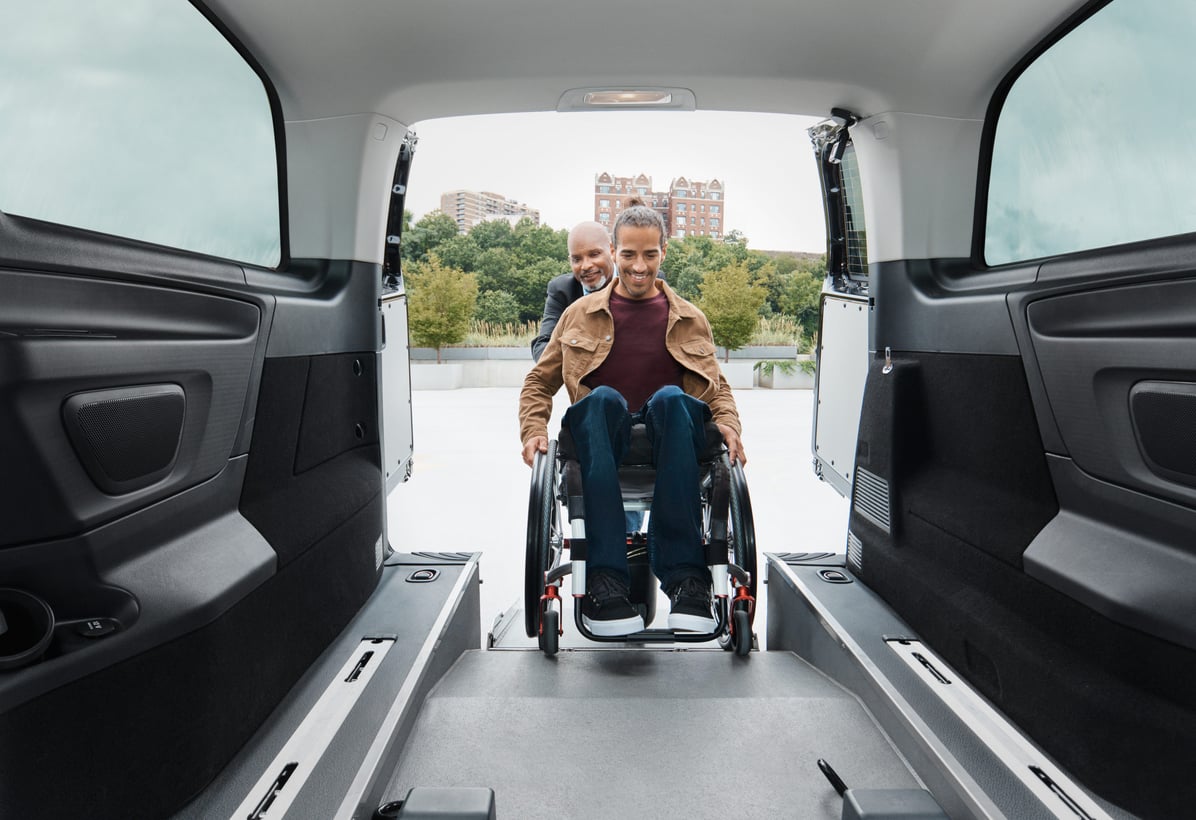On paper, paratransit sounds like a straightforward system. Riders call in to book a trip, and they are picked up and dropped off anywhere they want — all for the price of a bus ticket. Sometimes referred to as dial-a-ride or community transport, paratransit promises persons with disabilities and limited mobility more accessible, affordable, and equitable transportation. All they need to do is pick up the phone.
Unfortunately for many paratransit riders — a group with one of the greatest needs for affordable mobility options — actually using a city’s paratransit service can be less than enjoyable. Around the world, paratransit has a reputation for being unpredictable. Riders schedule their trips one to two days in advance, but the actual time they’re picked up can be an hour earlier or later than originally requested. Despite the two hour window, if the rider isn’t outside to meet his or her van within five minutes of the driver arriving, they’re considered a no-show.
Once riders are actually in the vehicle, the unpredictable trend often continues. Paratransit rides are shared, and the routes drivers take can sometimes defy logic. Hunter College student Jessica Champagnie told the New York Times that her trip from Manhattan to the Bronx once took a memorable three hours from start to finish because the driver was instructed to pick up another passenger in Queens. “Very rarely do they take me straight home,” said Champagnie, who uses a wheelchair. “It’s not a private limo service, but I wonder if they think about how long I’m in the vehicle.’’
And it’s not just New York. Each weekday afternoon, Christine Miles waits on the front steps of her Seattle-area home for a ride to work using the county’s paratransit service for people with disabilities. “Every single day, every single trip is different. It’s predictably unpredictable,” Miles told the Seattle Times. Imagine attempting to make it to work or a doctor’s appointment on time when your pickup and ride time are both unpredictable. Despite being federally mandated, paratransit can often leave much to be desired, both because of service quality challenges and how complex it is to operate such a service.
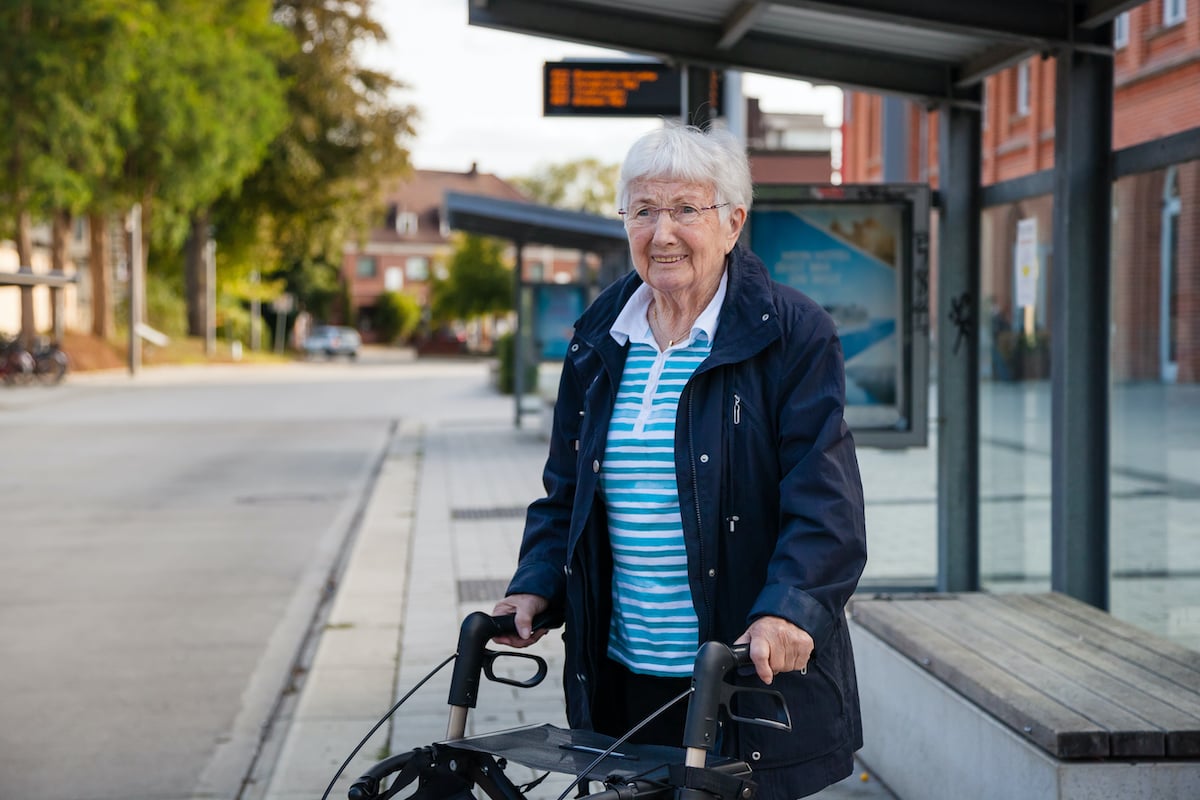
Providing accessible transportation for all.
Following the passage of the Americans with Disabilities Act (ADA) in 1990, the Federal Transit Administration (FTA) began mandating that paratransit services exist within ¾ mile of existing ambulatory public transportation in order to correct the fact that many people with mobility concerns could not easily — or in some cases could simply not — use this existing transit.
But given the delicate nature of paratransit, the policy gives operators flexibility around negotiated pick-up times and long pick-up windows. Combined with operational challenges such as riders canceling trips soon before pickup (therefore disrupting a planned schedule), vehicle breakdowns, and traffic congestion, most paratransit is highly unpredictable, and therefore not easily usable by anyone on a strict schedule.
This problem isn’t confined to the United States. Similar services that stem from laws addressing access for individuals with disabilities have also gone into effect globally in recent years — the Equality Act of 2010 in the United Kingdom; Law No. 2005-102 in France in 2005; and Germany’s Integration and Rehabilitation of Disabled People in 2001. Presently, paratransit and community transport services are concentrated in North America and Europe, despite the fact that persons with disabilities or mobility concerns account for approximately 15 percent of the global population.
According to Access Exchange International (AEI), accessible paratransit and community transport services are least available to low-income individuals with disabilities and seniors in countries around the world where they are needed most. Without effective and reliable transportation, those with disabilities have more difficulty unlocking the potential for employment, health care, education, housing, and community life as a result of limited access.
These common issues beg several questions, especially: what can be done to provide high quality, cost-effective accessible transportation?
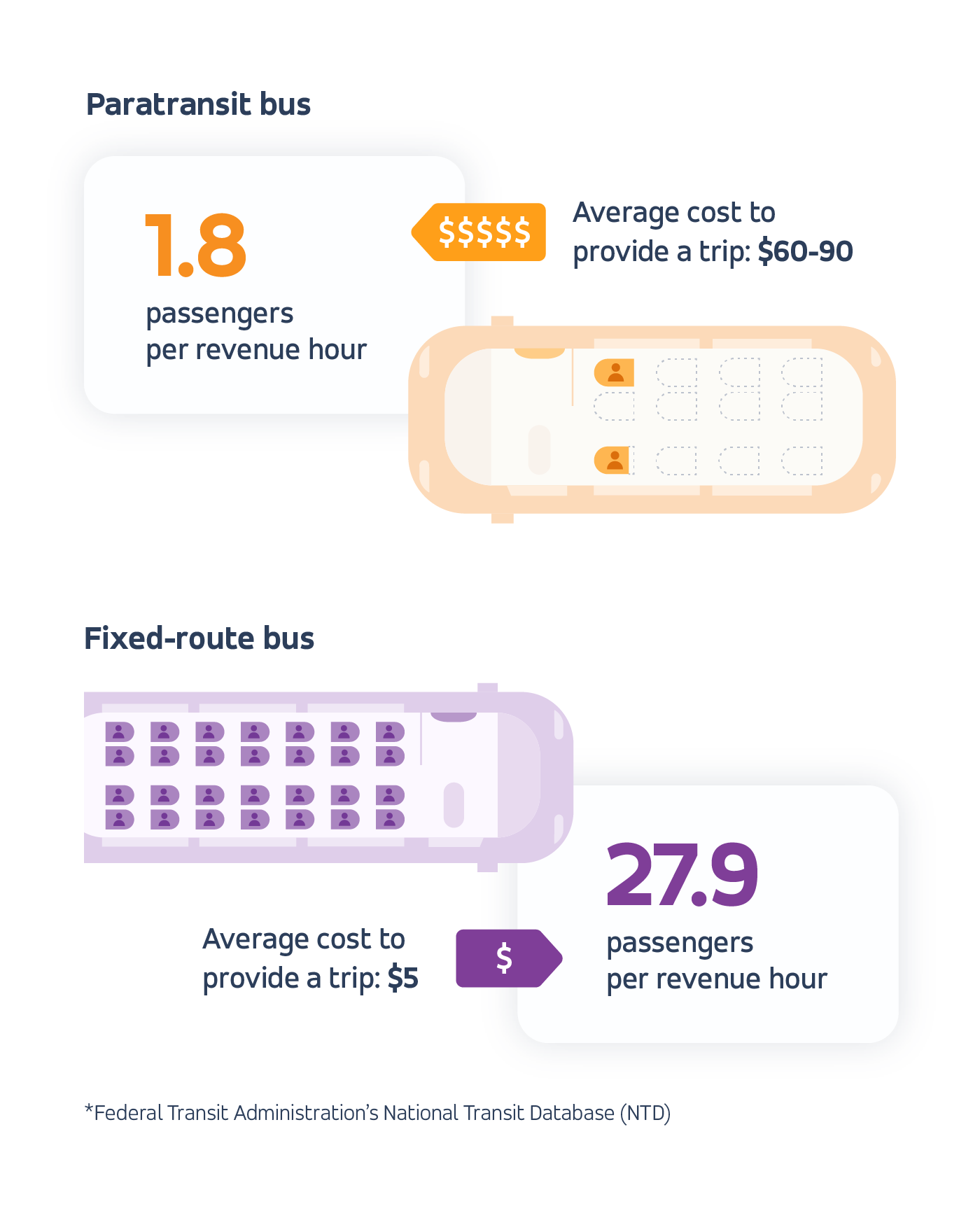
Why is paratransit so difficult to perfect?
In most instances, the answer comes down to a blend of issues all stemming from the fact that paratransit programs are often overlooked, and the cost to run them, even with designated funding resources, is significantly more expensive than traditional public transit. Concerns about operational costs result in many cities holding separate procurement processes for each aspect of the service — in some cases, vehicle operators, customer support, and overflow fleets are each managed by a different company. The move consequently forces the services to operate in silos, making day-to-day operations slower and less efficient.
On top of siloed operations, there is a general lack of new technology used to manage paratransit. Whether they operate the services themselves or outsource management and operations, cities often rely on little or outdated technology to streamline processes, making operations and customer service manual and inefficient. Insufficient technology also leaves users in the dark about their rides, as there are no real-time updates about where their driver might be, and when they will be picked up within that two hour window.
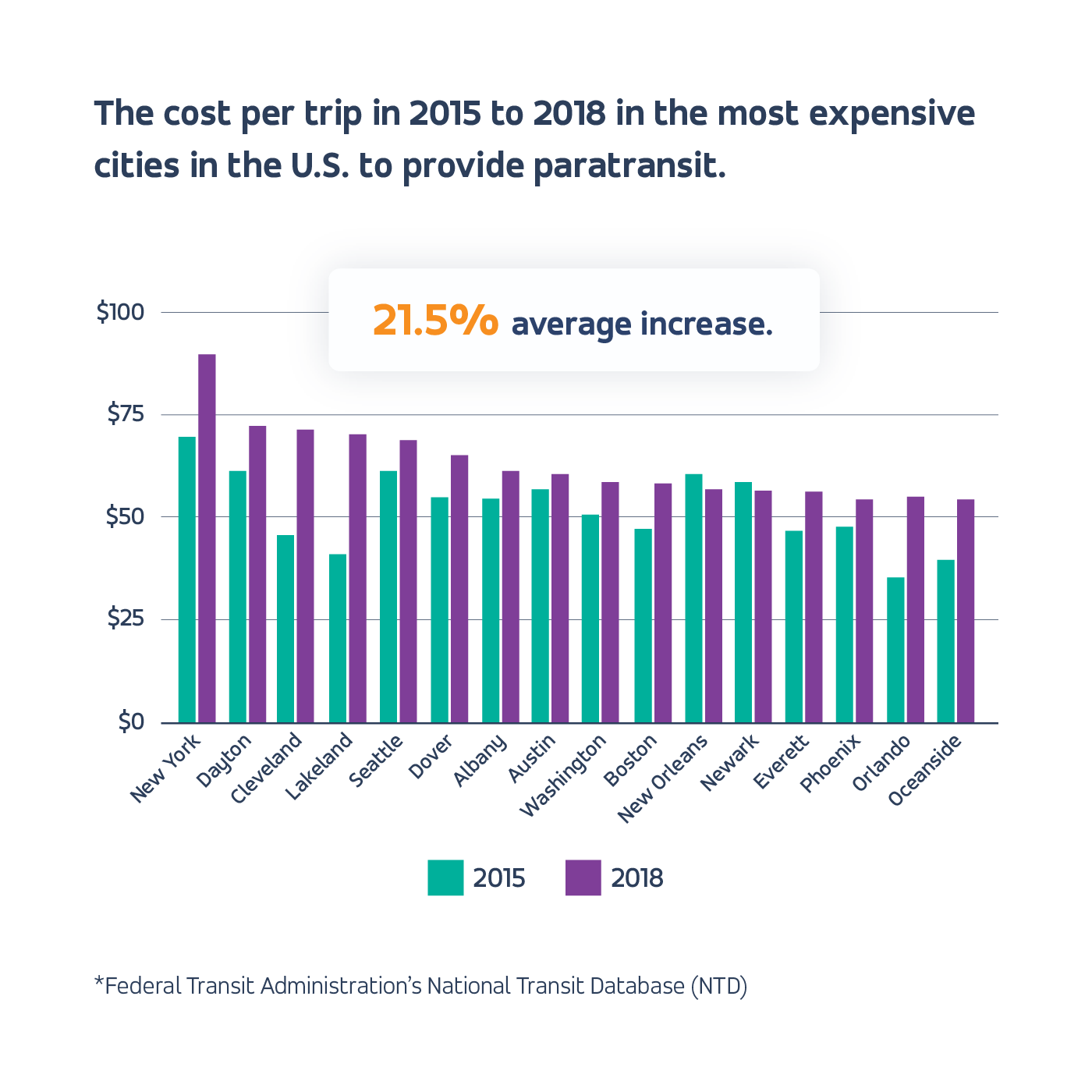
A combination of factors can also make paratransit services tremendously more expensive to operate when compared to traditional public transportation.
In Columbus, Ohio, the Central Ohio Transit Authority (COTA) found that the cost of providing paratransit continued to grow over time despite ridership staying relatively consistent, at approximately 278,000 trips per year, even after offering free bus fares to paratransit customers as an incentive to use the fixed-route service. COTA, like many agencies, is seeking ways to encourage certain paratransit riders to consider riding fixed-route service which, at an average per trip cost of $6.18, is much less expensive to provide than a paratransit trip, which averages $35.86 per trip.
In New York, demand is growing at five times the rate of subway ridership, according to a study by the Citizens Budget Commission (CBC). The report indicates that, despite growing demand, paratransit’s low productivity rate (or trips per hour) contributes to its ballooning costs of $616M annually.
In an effort to curb costs and provide better service for riders, cities are either mirroring COTA’s push to encourage more paratransit riders to take traditional public transportation, or in some cases, subsidizing rides served by taxis and other ride-hailing apps. However, most taxis and ride-hailing vehicles aren’t wheelchair accessible, meaning many drivers can’t accommodate rides for paratransit’s primary users. Beyond that, cities that have tested such service partnerships found them to be almost too popular with riders who don’t use wheelchairs, only increasing demand and the resulting costs associated with the service.

Paratransit is ready for a disruption.
Despite the common issues with paratransit services, some cities and transportation agencies are finding ways to use familiar technology to make a change. Just as we’ve seen a revolution in the personal transportation sector starting with ride-hailing technology and evolving into bikeshare and electric scooters, we are now seeing a similar wave hitting public transportation, and even paratransit. It’s just taking a bit longer.
Today, a number of transportation agencies in cities like Berlin, Seattle, and Sydney — including in rural cities like Leicester, UK — are deploying a new form of TransitTech -enabled services: On-demand microtransit. Using a mobile app or web portal, riders can book rides on-demand, when they need them, as opposed to days in advance. For these services, advanced algorithms enable multiple riders to seamlessly share the same vehicle in an endless flow without lengthy detours, or inconvenient fixed routes and schedules — a technological enhancement that could positively impact paratransit services’ frequently low efficiency. The technology can also easily accommodate for social distancing regulations in order to ensure that each ride meets safety requirements.
With intelligent routing algorithms, location tracking, turn-by-turn directions for drivers, and rigorous service planning, on-demand technology can offer increasingly affordable and accessible transit while improving common issues such as long waits, long trips, and high operating costs. But some city leaders question whether the same technology will work for paratransit, and whether riders are ready.
The truth is that the technology behind paratransit and microtransit have the same DNA, with a core focus on efficiently pooling riders by using an algorithm that pairs individuals headed in the same direction. This can be done days in advance or in real-time. However, paratransit riders have unique needs, and technology can and should be adapted accordingly.
While on the surface on-demand paratransit uses wheelchair-accessible vehicles, trained staff, and phone booking, it also provides key features to improve rider experience beyond improved routing. For instance, drivers receive real-time information about unique accommodations for individual riders, as well as stop and pickup information built into the digital map, which is highly customized (and can be adapted over time). Riders receive automated calls and texts to better inform them about their upcoming trips; and riders can book trips either by calling an operator like they’re used to or through an easy-to-use mobile app or web portal. A number of cities and transit agencies have already applied microtransit technology to their outdated paratransit programs, and results are proving to be immensely promising.

Cities carving a new path for paratransit.
Cities aren’t just talking about how to use microtransit technology to improve their paratransit services; they’re actually doing it. Despite federal regulations allowing for long pickup windows and booking days in advance, many transit leaders are realizing that service elements such as having a live map that shows riders the location of their driver is more of a necessity than a perk in current times. In April 2020, Green Bay Metro (GBM) — the public transit agency in Green Bay, Wisconsin — partnered with Via to launch a new and improved paratransit service. The new service uses TransitTech to solve long-standing transportation problems like unreliable scheduling and poor visibility into booked rides and vehicle locations. The new tech allows riders to book through a smartphone app, web portal, or by calling a live dispatcher.
Within just three months, GBM Paratransit significantly improved riders' travel experience, achieving a 97% on-time performance. Since launch, the service hasn’t missed a single trip. Hampton Roads Transit (HRT) in Virginia also invested in microtransit technology to refine the agency’s already robust paratransit service, and to eliminate functional silos across areas including customer service and operations. The agency’s network covers almost 400 square miles across six cities, and provides service for a large, loyal rider base.
In order to refresh operations, HRT invested in new ADA-compliant technology that optimizes vehicle usage while providing riders with as much flexibility as possible, allowing for pre-scheduled trips with plans to gradually introduce riders to the new option to also book trips on-demand. Because the new technology provider also manages customer support and operational elements such as fleet management and overflow rides, systems function cohesively. The vision: more efficient driver routing and dispatching will lead to a better rider experience as well as higher vehicle utilization, resulting in lower operational costs. Initial data shows on-time vehicle performance is already improving.
And in the City of Tyler, Texas, eligible riders have been riding the upgraded ADA paratransit service, since June 2021. This ridesharing service provides any resident who cannot use the fixed route system due to some type of disability with a reliable and affordable way to travel within the city of Tyler. Using smart algorithms, the network’s backend scheduling platform can optimize trip allocation to Tyler Transit’s own fleet and to third-party taxis. Automated route planning and fleet dispatching make the whole operation process much easier, while enabling more rides per vehicle hour and improving vehicle on-time performance. In less than two months since launching, the transit agency has seen huge, almost immediate benefits — it reaches an average utilization rate of 2.2 with 460 riders on average per week, and a 50% reduction in the number of overflow trips dispatched to third parties.
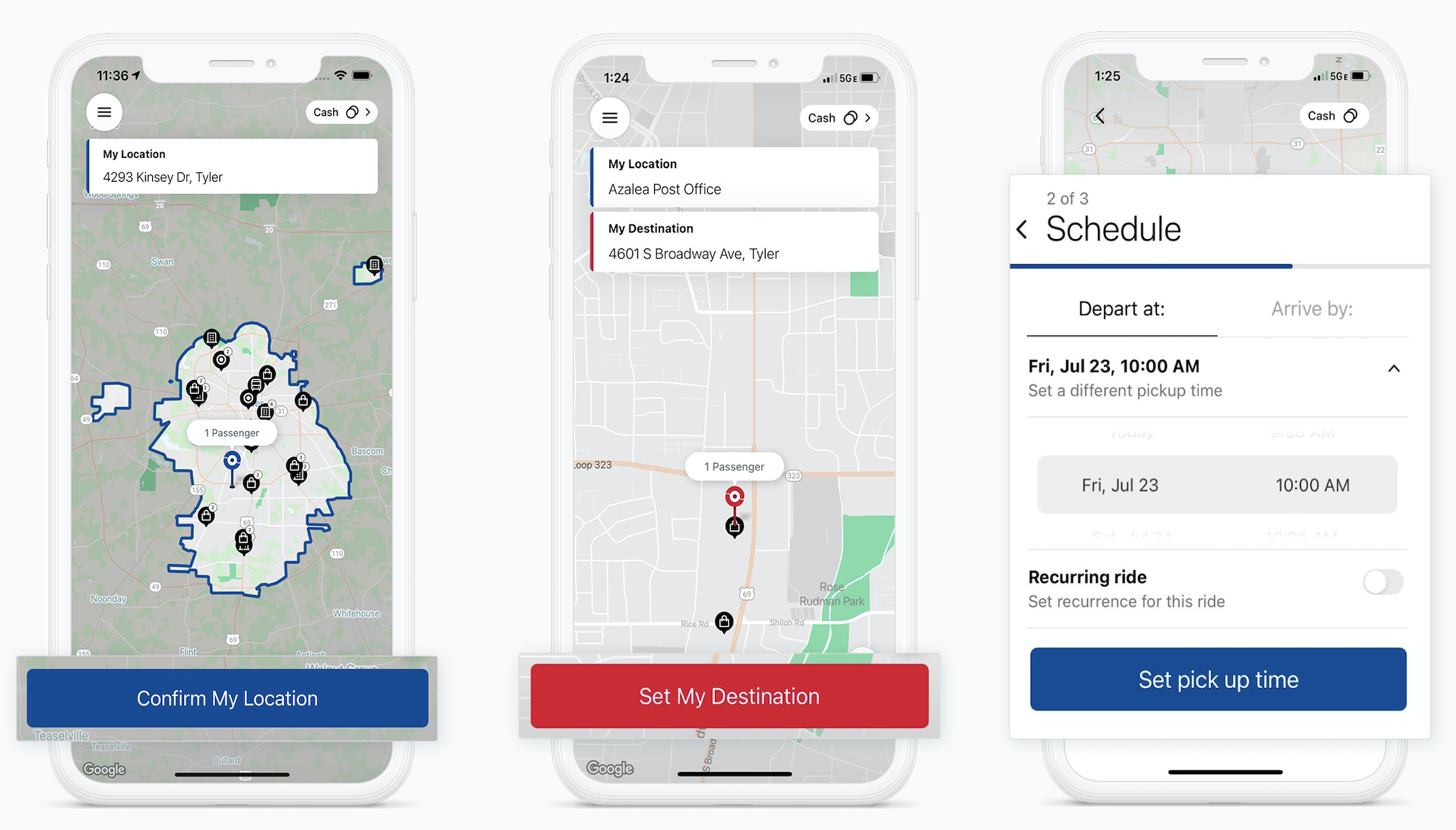
Technology that gives riders their freedom.
Aside from operational efficiency gains, TransitTech-powered paratransit also provides a new form of transparency and flexibility for riders. Technology formerly reserved for direct-to-consumer ride-hailing, including the ability to book a ride on-demand through a mobile app, track its whereabouts, and see your route, is finally becoming available for paratransit riders.
Paratransit riders in Green Bay enjoy new freedoms: With a real-time routing function, riders can book prescheduled and on-demand trips and easily manage departure time and cancellations all through a user-friendly app. The technology can automatically adjust routes and dispatching in response to riders’ changing needs. Riders especially appreciate new features like timely updates, which some riders say make their lives much easier. They can see where the driver was on the route, get pinged when the vehicle is close, and feel more in-control of their schedules.
Riders in Virginia have also started to see the benefits of technology-powered paratransit, even after switching from a legacy paratransit provider that enjoyed strong ridership. Users knew their booking dispatcher by name, and they recognized the routes that took them to their weekly appointments.
These comforts of the legacy service made the transition to a new operator a challenge. But, within two months of launch, the new service enjoys lower call-in wait times, fewer late pickups, and an improved rider experience — a strong testament to the adaptability of the new technology HRT began using to modernize its service. Some of the strongest and most common feedback about the new service came down to a simple text message. Riders began receiving automated SMS notifications when their vehicle neared their pickup location, which some riders called the greatest perk of all.
TransitTech-enabled paratransit services are also customizable, tailored to the unique needs of the local paratransit-eligible community, meaning riders can get the services that they particularly long for. With ten dedicated vehicles and four non-dedicated taxis providing paratransit service in the city of Tyler, this updated network covers a 54-square-mile area, including both dense and lightly-populated neighborhoods. Notably, the city has also gone beyond ADA required service zone, which is 3/4 of a mile on either side of a fixed route service. It now provides full coverage to all origins and destinations inside the city limits in order to better support riders’ diverse needs.
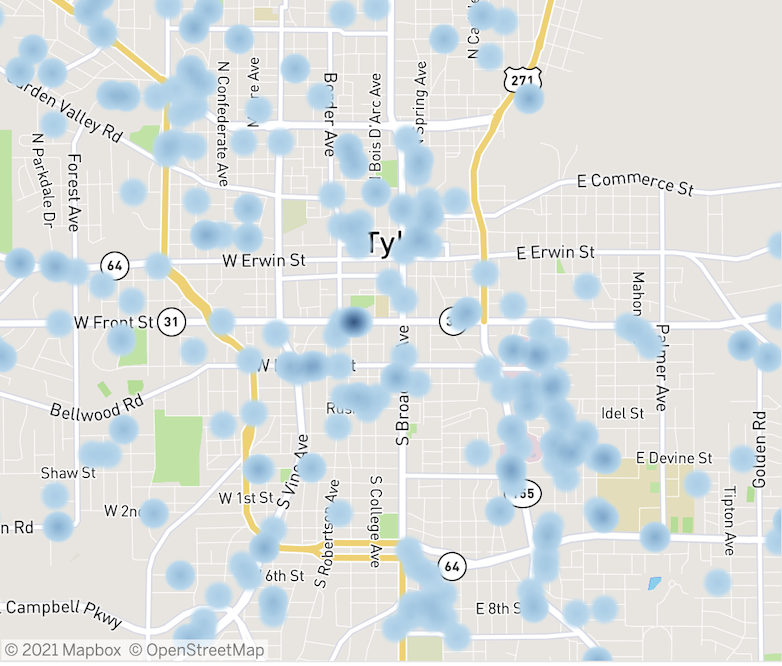
The next wave of the transportation revolution.
Paratransit may currently be an underdog, but as public transportation continues to evolve, the future of such services looks bright. As transportation leaders and riders continue to embrace on-demand microtransit as a complement to traditional buses with fixed routes and schedules, they will likely turn to similar technology to improve the paratransit experience.
New technology offers a more enjoyable rider experience and a greater opportunity for seniors and individuals with disabilities to easily access their workplaces and communities — as well as the potential for more efficient operations and lower costs for agencies, cities, and taxpayers. Indeed, several agencies and thousands of individuals who rely on accessible transportation are already looking towards a technology-enabled future.
